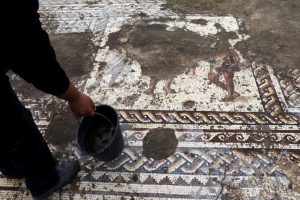Archaeologists discovered a 1800-year-old mosaic dating back to the Roman era in the ancient city of Caesarea in West Israel.

The mosaic was discovered during the excavation of a building from the Byzantine period, which was built over the site of the mosaic. The excavated portion of the mosaic measures 3.5 metres by 8 metres. It is of a very high artistic standard and is made with around 12000 tesserae per square metre. It depicts three toga-clad men, as well as geometric patterns and an inscription in Greek, which is damaged. Peter Gendelman, who is leading the excavations, states that it is not sure whether the mosaic came from a mansion or a public building. If the mosaic came from a mansion, the figures could have been the owners, or if it was a public building, they may have been the mosaic’s donors or members of the city council.

Caesarea was a vibrant Roman metropolis built in honour of Emperor Augustus Caesar by King Herod, who ruled Judea from 37 BC until his death in 4 BC. The archaeologists excavating the are of the Byzantine building state that it is a surprise that two such beautiful monuments from the glorious days of Caesarea have been unearthed.

(after Nir Elias & Reuters)